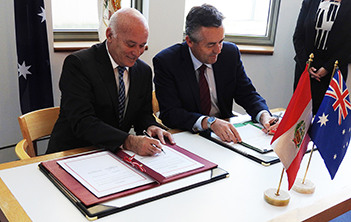Peru and Australia ink FTA
- News Feed
- Wednesday, 23 August 2017
Not many Australians know much about Peru. Even though Machu Picchu with its remarkable Inca citadel is quite familiar, placing it in Peru might not be as easy to most. But Peru is already a substantial trading partner with Australia and chances are it's going to get a lot more important quite rapidly.
This will be due largely to the launching of Peru-Australia Free Trade Agreement negotiations and the signing of a bilateral air agreement.
Australia has also begun FTA negotiations with the Pacific Alliance of which Peru is a member, along with Mexico, Chile and Colombia. This is a significant trade bloc - its joint GDP was more than US$1.8 trillion last year and those four countries account for 57 per cent of Latin America's imports.
Industry leaders are already pointing to significant potential in Peru if the current tariff barriers - some of them very high ones - are eased and Australia begins to benefit from the same levels of preferential access enjoyed by the US, EU and Canada via FTAs.
The foundation stones are already in place: Peru is a fellow (and active) member of APEC and was one of the TPP signatories. It could be involved in the possible renaissance of TPP in amended format.
 If all goes well - and the mood is upbeat on both sides, it seems - the FTA will be of value to the Australian transport sector, including air cargo. And air movements will be helped by the newly-signed agreement.
If all goes well - and the mood is upbeat on both sides, it seems - the FTA will be of value to the Australian transport sector, including air cargo. And air movements will be helped by the newly-signed agreement.
(Signing the Australia-Peru aviation agreement are Eduardo Ferreyros Kuppers [left] and Steven Ciobo.)
Currently there are no scheduled cargo or passenger services between the two countries and only a few scheduled Peru/Asia Pacific links, notably a Korean Air Cargo freighter service.
Peru has several airlines, including Avianca Peru and Latam Peru but their networks, while extensive, are largely confined to the Americas with just one or two European links.
However, Jorge Chávez International Airport (JCIA) www.lima-airport.com which serves Lima, the capital, is one of Latin America's key cargo hubs with a large number of freighters moving through daily, including several long-haul.
Jorge Chávez was one of the true pioneers of world aviation but is little known in this part of the world. In Peru he's considered a hero.
Cargo throughput at JCIA in 2015 was 350,844 tonnes. It has been on a steady upward curve since 2009, although that year was only a relatively small blip in an early growth line. 2009 was also the year Lima Cargo City was opened at the airport. A new cargo terminal is planned in phase three of a long-running airport expansion program.
Eduardo Ferreyros Kuppers, Peru's minister for Foreign Trade and Tourism visited Australia to kick off the FTA negotiations and sign the air agreement.
Steven Ciobo, his Australian counterpart, said "Peru presents a growing opportunity for Australian exporters that this FTA will help unlock. Over the last decade, Peru has been one of the fastest growing economies in Latin America, and the world, with annual GDP growth averaging 5.9 per cent 2005-2015.
"Many of Australia's exports to Peru are blocked by high tariffs that this FTA will seek to eliminate. Australian dairy and sugar exports currently attract tariffs of up to 29 per cent, beef exports face tariffs of up to 17 per cent and sheep meat, wheat, rice and wine also face tariff barriers."
Australia's services exporters could also benefit from an FTA, Ciobo suggested, because "Peru is increasingly looking offshore for specialised services".
This could be of value to air cargo, opening up possibilities for support equipment transfers.
And, said Ciobo, "an FTA with Peru would be another gateway to Latin America, strengthening our economic relationship with the region and enabling Australian business to tap into value chains between the Americas and Asia".
First round of formal negotiations was in Lima in July. The process is not expected to be drawn out interminably like some FTAs in the past.










